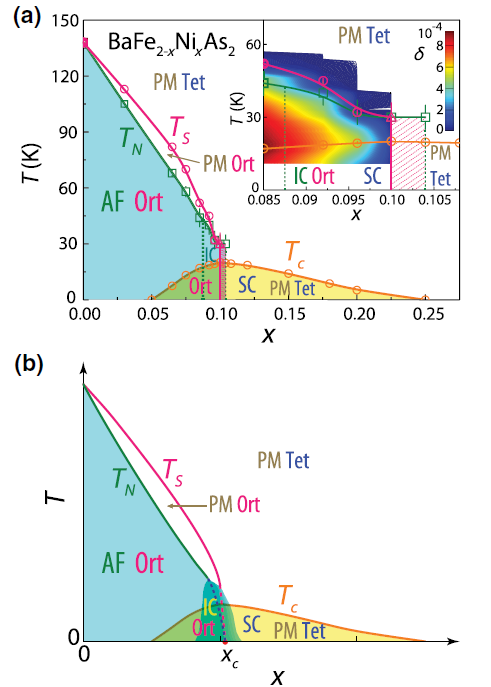Avoided Quantum Criticality and Magnetoelastic Coupling in BaFe2-xNixAs2
Date:25-06-2013 Print
A determination of the structural and magnetic phase diagram in correlated electron materials is important for understanding their underlying electronic excitations. In the iron pnictides, superconductivity arises at the border of both antiferromagnetic (AF) and structural orders. This motivates the exploration of quantum critical points (QCP), where the transition temperatures for such orders are continuously suppressed to zero by a nonthermal control parameter. Indeed, recent studies on the electron doped Ba(Fe1-xCox)2As2 and the isoelectronically doped BaFe2(As1-xPx)2 suggest there is a QCP around the optimal doped level. To further support such conclusion, one important work should be done is the detailed electronic phase diagram about the electronic phase transitions especially nearby the optimal doping.
Recently, Prof. DAI Pengcheng’s team from Beijing National Laboratory for Condensed Matter Physics at the Institute of Physics, Chinese Academy of Sciences focused on the electron doped iron arsenide BaFe2-xNixAs2 and carried out systematic studies by neutron scattering for the quantum criticality issue. One key result is the short ranged incommensurate magnetic order when approaching optimal doping, which coexists and competes with superconductivity, leading to the absence of magnetic QCP around optimal doping. Such conclusion challenges the universality of quantum criticality in iron-based superconductors.
To understand why the QCP does not emerge in BaFe2-xNixAs2 system, LU Xingye, ZHANG Rui and LUO Huiqian in Prof. DAI Pengcheng’s group, in collaboration with GRETASSON Hlynur and KIM Young-June from University of Toronto have done extensively studies on the structure transition and magnetic transition in BaFe2-xNixAs2 single crystals by using the high resolution synchrotron X-ray diffraction and elastic neutron scattering techniques. They obtained the refined phase diagram of BaFe2-xNixAs2, in agreement with the quantum phase transition theory proposed by Prof. NEVIDOMSKYY Andriy and Prof. SI Qimiao from Rice University. While the phase diagram is mostly consistent with the earlier work on Ba(Fe1-xCox)2As2 at low electron-doping levels, their key new finding is that when Ni doping x approaches optimal doping, the magnetic and structural transition temperatures converge to the purported quantum bicritical point, with both order parameters disappearing near x =0.1 as a result of magnetoelastic coupling. However, the emergent short-range incommensurate magnetism helps the system avoid the quantum critical fate, resulting in an apparent saturation of Ts=TN=30K above the superconducting Tc near optimal doping x=0.1. These results elucidate the quantum criticality in the carrier-doped iron pnictides and its connection with that of the isoelectronically doped counterparts, and reveal a rich theoretical picture that should be further explored in future work.
This work was published on the Physical Review Letters [Phys. Rev. Lett. 110, 257001 (2013)]. The neutron scattering experiments were done with the help from TIAN Wei at Oak Ridge National Laboratory, YAMANI Zahra at Canadian Neutron Beam Centre and LAVER Mark at Paul Scherrer Institute. The X-ray diffraction experiments were done at the National Synchrotron Light Source, Brookhaven National Laboratory with the help from LIU Xuerong. It was supported by the National Basic Research Program of China (Grant No. 2012CB821400 and 2011CBA00110) and the National Science Foundation of China (Grant No. 11004233), together with other grants from USA and Canada.
 |
| (a) Electronic phase diagram of BaFe2-xNixAs2as a function of Ni doping x as determined from neutron and x-ray scattering experiments. The PM Tet, PM Ort, AF Ort, and IC Ort are paramagnetic tetragonal, paramagnetic orthorhombic, commensurate AF orthorhombic, and incommensurate AF orthorhombic phases, respectively. The inset shows the expanded view o Ts, TN, and Tcand temperature dependence of the orthorhombic lattice distortion order parameter. (b) Schematic theoretical phase diagram for an avoided quantum bicritical point.(Image by Prof. DAI Pengcheng et al.) |

